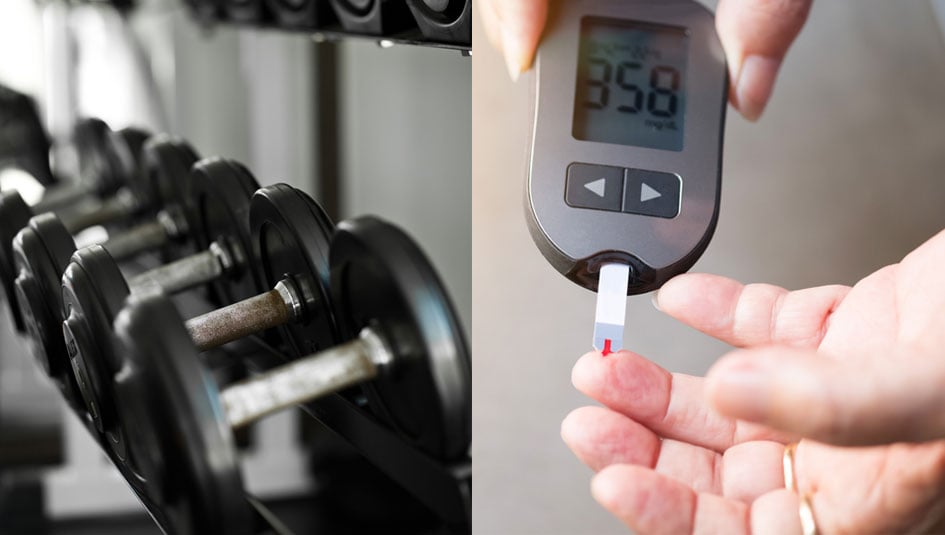Why Does Weightlifting Make My Glucose Levels Skyrocket?

Opinion
My family has a history of Type 1 diabetes and other autoimmune diseases and I tried to maintain a healthy, active lifestyle in what eventually proved to be a futile attempt to stave off my genetic predisposition. I was profoundly disappointed when, after 63 years of keeping myself in great shape, I developed Type 1 diabetes.* There were no real answers as to why this happened, but one possibility that was raised by others was that it came about because of the stress of caring for my wife after she developed multiple sclerosis.
Type 1 diabetes presented a host of new challenges, but since I was already devoted to looking after my health, I found that very little changed in my life. Sure, there was the huge learning curve of trying to balance glucose levels with insulin, but I am a big fan of control so I quickly took to this routine. Since my diagnosis, I stepped up my game of self-care, especially when it came to my diet. I cook all my own meals and carb-counting has almost become an obsession.
However, my biggest challenge has been exercise, when my glucose levels go high. My workout routine for the past 45 years has been weightlifting, and I do it on average four times a week. But soon after my diagnosis, I found that Type 1 diabetes caused a conundrum to this routine – I was seeing glucose levels of 7 mmol/L (126 mg/dL) to 8 mmol/L (145 mg/dL) pre-workout and 12 mmol/L ((216 mg/dL) to 14 mmol/L (250 mg/dL) post-workout.
Read more: JDRF rolls out its PEAK program on exercise and Type 1 diabetes
I wanted to understand why. I had a lot of discussions with my endocrinologist and diabetes educator. I also started to read and attend numerous lectures and workshops on the subject. Inevitably, though, the discussions always seemed to be about aerobic exercise, and my questions about weight training received vague answers from researchers and doctors – “Everybody is different.”
Personal trial and error seemed to be the only approach. Luckily, one of the seminars mentioned Ginger Vieira’s book, Your Diabetes Science Experiment. This book ended up being a great starting point for me. I began to do as Vieira suggested and tinker with my self-care; I modified my insulin intake before going to the gym and found I was able to achieve better glucose control.
Then, a year or so ago, things started to go downhill again. My glucose levels started going way out of bounds, with post-gym levels of 16 mmol/L (288 mg/dL) to 18 mmol/L (325 mg/dL). Worse, it seemed that almost any form of exercise was having this effect – yoga could push me up to 14 mmol/L (250 mg/dL) and golf games ended up as high as 21 mmol/L (375 mg/dL). I’ve turned back to trial and error with diet and insulin dosage.
Recently, I turned to the internet, hoping there would be some new and enlightening information out there. During the course of my research, I came across Craig Idlebrook’s recent article “25 Facts to Know on Exercise on Type 1 Diabetes.” While highly informative, I found that much of what it had to say about exercise did not relate to my situation. Much of the information could be applied to the general public, and the first section of the article was more of a recommendation to exercise, rather than facts about exercise and Type 1 diabetes, specifically.
Read more: 25 facts to know on exercise and Type 1 diabetes
When the discussion turned to what happens to glucose levels during exercise, the article became much more focused. Still, what I was reading was not consistent with my experience of anaerobic intense exercise and glucose levels. I understand that it was a condensed version of the main write-up, and my next goal is to read the whole report for a more in-depth understanding of the research findings. My concern with this type of article, however, is that individuals could take some of the facts out of context and get themselves into trouble.
My favorite fact turned out to be #25:
“Of course, every individual’s blood sugar levels react differently to exercise. Also, more research is needed, especially on pump use and exercise, before researchers can ever hope to provide ironclad, always-going-to-work guidelines. Therefore, it’s best to monitor your blood sugar levels frequently around exercise, and treat fluctuations accordingly.”
Everybody is unique; I am the only one who can control my glucose levels; and I am responsible for looking after my diabetes. Until research is done to tease out guidelines based on these unique, individual reactions to exercise, control always comes back to individual initiative.
*Editor’s note: There is still so much we have yet to understand about why Type 1 diabetes initiates. However, we do know it is never anyone’s fault. Staying in shape is great, but scientists have not found evidence that exercise can dodge the genetic bullet of Type 1 diabetes.
This article has been edited for length and clarity.
Thanks for reading this Insulin Nation article. Want more Type 1 news? Subscribe here.
Have Type 2 diabetes or know someone who does? Try Type 2 Nation, our sister publication.